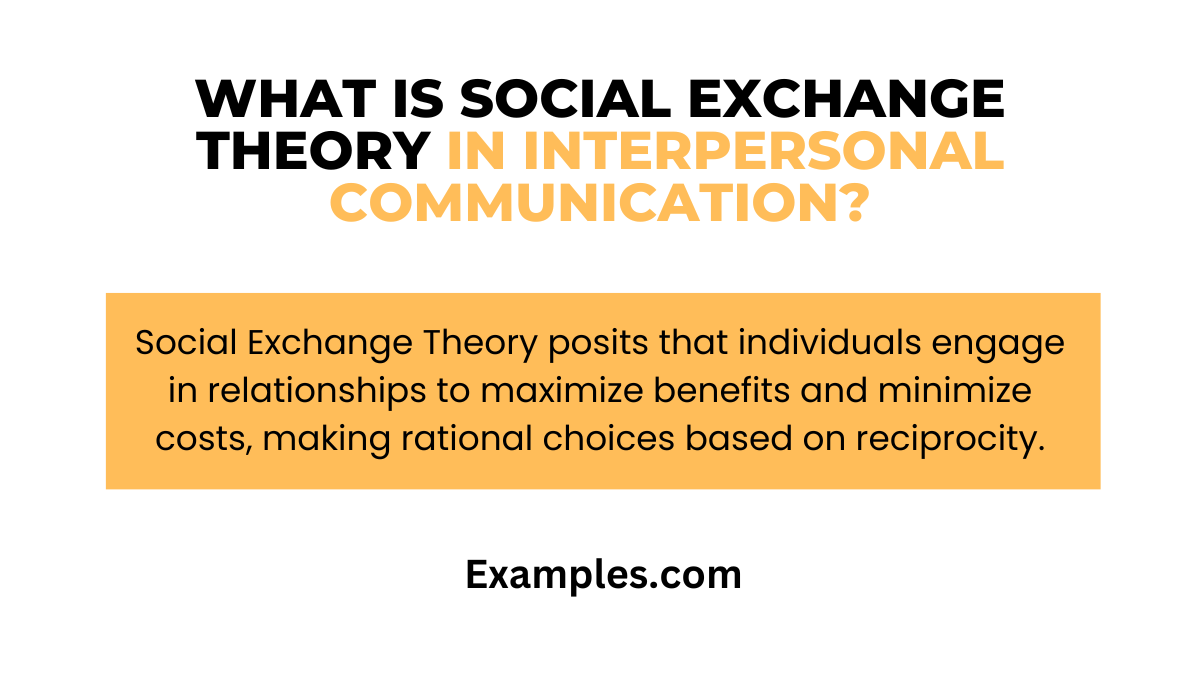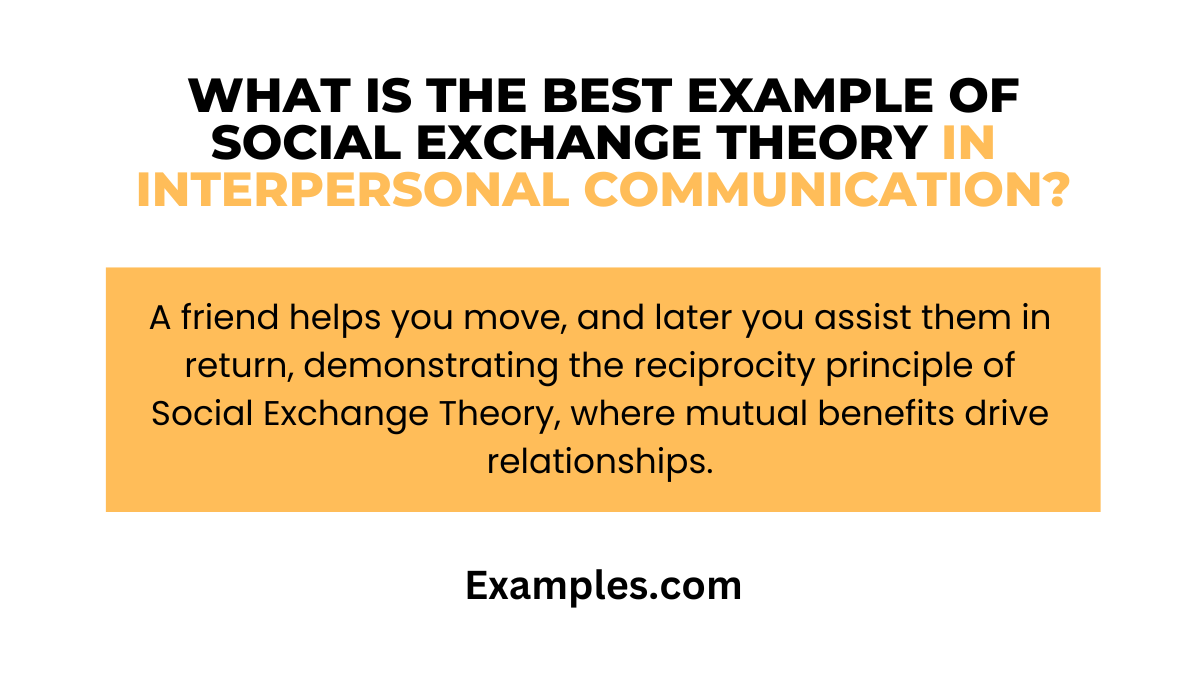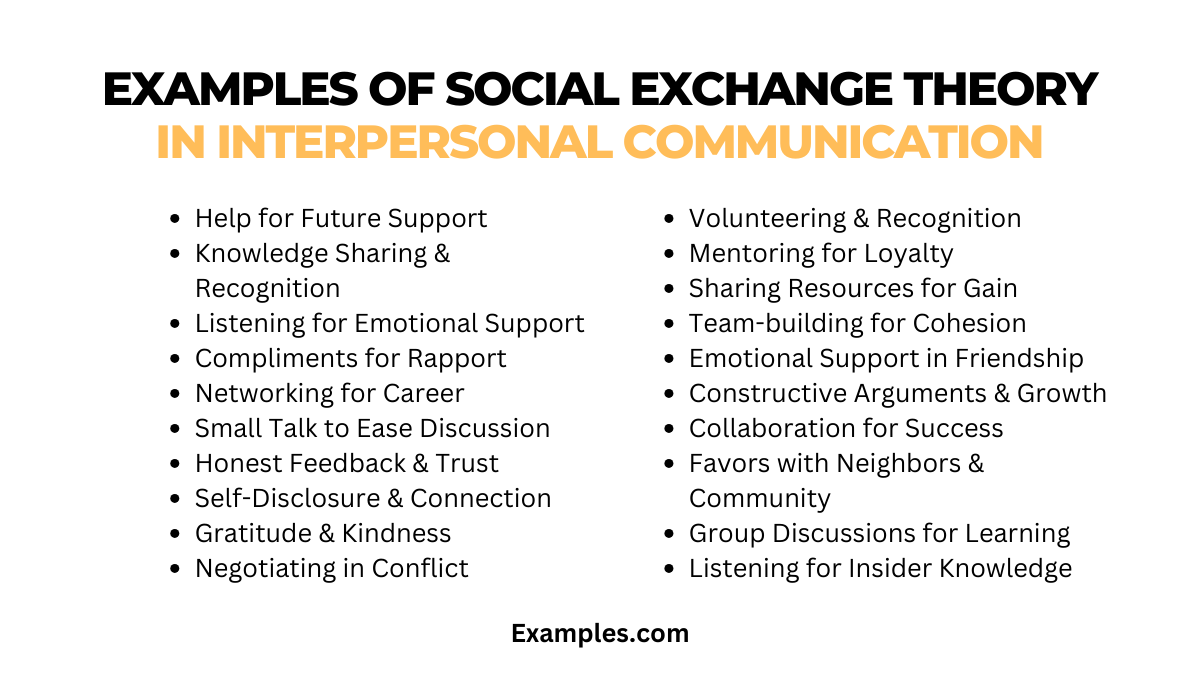19+ Social Exchange Theory in Interpersonal Communication Examples
Understanding Social Exchange Theory in Interpersonal Communication is crucial for enhancing our everyday interactions. This theory explains how individuals evaluate and regulate their relationships based on perceived benefits and costs. It’s not just about what we say, but how we balance emotional investments and rewards to foster healthier, more satisfying connections. Our guide offers practical examples and tips, making complex concepts easily accessible for anyone interested in improving their communication skills.
What is Social Exchange Theory in Interpersonal Communication?

Social Exchange Theory in Interpersonal Communication is a psychological and sociological perspective that explains how human relationships are formed and maintained. At its core, this theory suggests that individuals seek to maximize rewards and minimize costs in their interactions with others. It’s not purely transactional but involves evaluating emotional, social, and sometimes material benefits against potential negatives like stress or conflict. This theory helps us understand why and how people invest in relationships and the dynamics that sustain or end them.
History
Who Created: George Homans and Peter Blau
Date: 1960
The origins of Social Exchange Theory date back to the early 20th century. It was initially influenced by the work of behavioral psychologists who studied the principles of reinforcement. However, the theory gained substantial recognition in the field of Interpersonal Communication through the works of sociologist George Homans in the late 1950s and early 1960s. Homans focused on the elemental forms of social behavior, proposing that human interactions are a series of exchanges where individuals seek to maximize rewards and minimize costs.
What is the Best Example of Social Exchange Theory in Interpersonal Communication?

One of the best examples of Social Exchange Theory in Interpersonal Communication can be seen in friendships. In a healthy friendship, both parties enjoy benefits like emotional support, companionship, and shared experiences. These positive aspects often outweigh any costs, such as the time and effort invested in maintaining the relationship. When both friends feel that they are gaining more than they are giving up, the friendship thrives. Conversely, if one person perceives the costs as too high – for instance, if they feel taken for granted or overburdened – the friendship may deteriorate. This example illustrates the delicate balance of give-and-take essential in sustaining interpersonal relationships.
20 Examples of Social Exchange Theory in Interpersonal Communication

Social Exchange Theory in Interpersonal Communication offers invaluable insights into the give-and-take dynamics of our daily interactions. This theory, pivotal in the realms of Interpersonal Communication, posits that individuals seek to maximize rewards and minimize costs in their relationships. Understanding this theory enhances our ability to navigate complex social landscapes, be it in personal relationships, the workplace, or broader social settings.
- Offering Help in Exchange for Future Support: “If I help you with this project, could you assist me with mine next week?” This verbal commitment establishes a reciprocal understanding.
- Sharing Knowledge for Recognition: “I’ll explain this concept to you, which could boost our team’s performance.” It’s a strategic exchange of information for potential status enhancement.
- Listening to a Friend’s Problems for Emotional Support: “Tell me what’s bothering you, and I’ll be here for you too when you need it.” This emotional barter strengthens bonds and mutual reliance.
- Complimenting to Build Rapport: “I admire your work ethic. Could we discuss your strategies sometime?” Compliments can pave the way for beneficial knowledge exchange.
- Networking at Professional Events for Career Opportunities: “Great presentation! Can we connect on LinkedIn?” This tactic combines verbal and digital communication to open future career doors.
- Engaging in Small Talk to Ease into a Serious Discussion: Starting with light conversation before addressing significant matters can create a comfortable environment for more profound exchanges.
- Offering Honest Feedback in Exchange for Trust: “I’ll give you my honest opinion, and I trust you to do the same for me.” This establishes a foundation of mutual respect and sincerity.
- Balancing Self-Disclosure to Build Closer Relationships: Sharing personal experiences with someone who reciprocates fosters a deeper connection.
- Expressing Gratitude to Encourage Continued Kindness: “Thank you so much for your help; how can I return the favor?” Gratitude can motivate ongoing positive interactions.
- Negotiating in Conflict Resolution for Mutual Satisfaction: “Let’s find a middle ground that benefits us both.” This strategy aims for a win-win situation, enhancing the relationship.
- Volunteering Time for Community Recognition: Offering time and effort for community projects can lead to social recognition and further opportunities.
- Mentoring a Junior Colleague for Loyalty: Investing time in someone’s career development can cultivate loyalty and a supportive future relationship.
- Sharing Resources for Mutual Gain: “If we share our resources, we can both achieve our goals more efficiently.” This approach optimizes benefits for all involved parties.
- Initiating Team-building Activities to Foster Group Cohesion: Organizing activities that bring people together can strengthen group dynamics and individual alliances.
- Providing Emotional Support to Strengthen Friendship Bonds: Being there for someone in tough times often ensures their support when you need it.
- Engaging in Constructive Arguments for Personal Growth: Challenging discussions, when handled respectfully, can lead to mutual development and understanding.
- Collaborating on Projects for Shared Success: “If we work together, we can both shine in this project.” Collaboration can lead to shared accolades and recognition.
- Exchanging Favors with Neighbors to Build a Supportive Community: Helping neighbors in the expectation of future assistance fosters a supportive local network.
- Participating in Group Discussions for Learning and Sharing: Active involvement in group conversations allows for the exchange of ideas and knowledge.
- Offering a Listening Ear in Exchange for Insider Knowledge: “I’m here to listen, and maybe you could give me some insight into the issue?” This tactic is beneficial in gathering essential information while offering support.
Social Exchange Theory in Interpersonal Communication in Relationships
- Decision Making in Relationships: Social Exchange Theory plays a crucial role in how people decide to start, continue, or end relationships. People evaluate their relationships based on the perceived balance between what they put into the relationship and what they get out of it.
- Reward and Cost Assessment: The rewards in a relationship can include companionship, emotional support, and shared experiences. Costs can be emotional, physical, or even financial. The theory posits that for a relationship to be maintained, the rewards must outweigh the costs.
- Comparison Level: This is a standard by which people evaluate the desirability of a relationship. It is based on past experiences and societal norms. If the current relationship meets or exceeds this comparison level, it is viewed positively.
- Comparison Level for Alternatives: It involves comparing a current relationship to the possibility of having another relationship or being alone. If alternatives are perceived as better, one might choose to leave the current relationship.
- Equity and Equality: Social Exchange Theory also underscores the importance of equity in relationships. Inequity, where one person feels they are putting more into the relationship than they are receiving, can lead to dissatisfaction and eventual decline of the relationship.
- Application in Various Relationships: The theory applies to different types of interpersonal communications, such as Verbal Communication in expressing needs and concerns, Non-Verbal Communication in showing affection or discontent, and Digital Communication in maintaining long-distance relationships.
- Criticism and Limitations: Some critics argue that the theory overly simplifies human relationships and doesn’t account for the complexities of emotions and cultural influences. Moreover, it assumes that people are always rational and calculative in their relationships, which might not always be the case.
What are the Key Concepts of Social Exchange Theory in Interpersonal Communication?

- Reward and Cost Assessment: Individuals evaluate each interaction and relationship based on the rewards (such as emotional support, companionship) and costs (like time, emotional strain).
- Comparison Level: This refers to the standard against which all relationships are evaluated. Based on past experiences and societal norms, this level shapes expectations and satisfaction in a relationship.
- Comparison Level for Alternatives: It involves comparing the current relationship to potential alternatives. If alternatives are perceived as better, individuals may opt to leave the current relationship.
- Equity: A critical aspect where individuals seek fairness in relationships. Unequal distributions of rewards and costs can lead to feelings of injustice and dissatisfaction.
- Interdependence: The degree to which partners in a relationship depend on each other also defines the dynamics of interpersonal interactions.
Social Exchange Theory highlights the cost-benefit analysis in interpersonal communication. Effective communication involves understanding this dynamic to foster rewarding relationships. Remember, balance is key; aim for mutually beneficial exchanges. Embrace active listening, clear expression, and empathy for successful interactions. Mastering this theory can significantly enhance your interpersonal communication skills, leading to more fulfilling personal and professional relationships.



